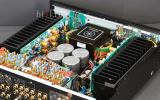Same here, that’s what I liked about the Rekkr.
But even for my limited needs, 4 would not be enough.
You might be right, placement and/or proximity must have an effect.
Iota pa3 is symmetrical, and does not hum, while Cambridge axa25 is not symmetrical, and did hum.
Is there a real relation here?
I didn’t spend much time optimising it with the transfo out but I do remember the cloth did most of the trick.
It would also sound differently when manipulated by hand.
Could be the weight distribution pressuring wires differently (it felt like few kgs), or/and in relation to my ears.
Placed vertically didn’t help for example.
(Here I must say I did search about safety before touching it “live”, didn’t find anything for this dumb case so just did it since it’s all wrapped, let me know if I should have died...).
Just nude on wood it did still hum, but I don’t remember how much less.
But outside + cloth was the best, better than inside + rubber and stuff.
Cloth was also thicker than the felt I finally used, it’s just too tight in there.
That’s why I thought about a new case, a symmetrical build with a bigger transformer feeding both, maybe audio grade.
Sure it’s probably going too far…but I entertain the idea!
About electric isolation, I’d be curious if the rubber did anything since the screws could still conduct from cover to the sides.
I had to raise it anyway for the new height and wires.
Thought about covering it with a metal box, but a faraday cage would mean butchering the case a lot.
And it’s quite impossible to add even just a metal plate between it and the pcb.
I would rather replace it with a
Toroidy, not that
expensive for the regular audio grade, but a little too big for the
supreme one.
Btw, in my conversation with Schiit they acknowledged it could hum, but I don’t want people to think it’s a crazy hum.



